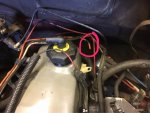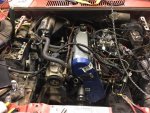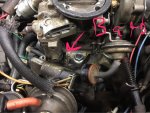bilbo
Well-Known Member
- Joined
- Oct 29, 2016
- Messages
- 867
- City
- South Florida
- Vehicle Year
- 1983
- Engine
- 2.3 (4 Cylinder)
- Transmission
- Manual
- Total Lift
- 0
- Total Drop
- 0
I'm hoping someone with an 83 or close to it will be able to help me out. I can't figure out where an orange vacuum line goes. It is the one circled in the photo. The diagram shows it going into CARB-U but I don't know what that means. It won't reach anything near the carb (it may be broken). Is CARB-U on the left (fender) side of the carb near the bottom? The truck is a 2.3 with air conditioning.
Also, where should the thick battery ground and the other ground on the left side of the engine attach? The wiring harness kind of fell apart and it's dangling free. I can't find it in any of my photos taking things apart. Thanks in advance for any help!
Also, where should the thick battery ground and the other ground on the left side of the engine attach? The wiring harness kind of fell apart and it's dangling free. I can't find it in any of my photos taking things apart. Thanks in advance for any help!















